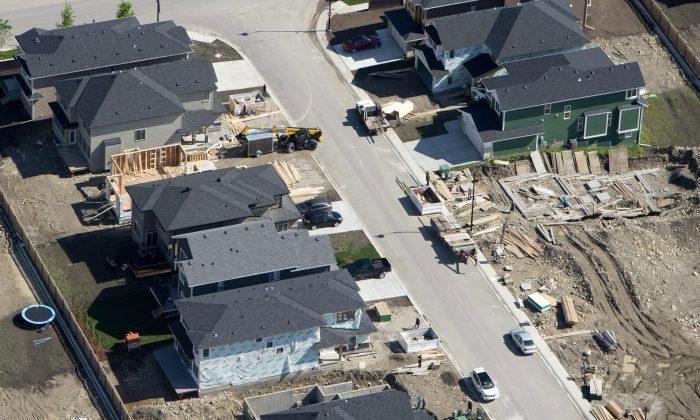Despite flooding in Alberta and a construction strike in Quebec, the annual rate of housing starts dipped only slightly in June, leaving economists divided over whether the market has achieved the desired cooling or is headed for an oversupply.
The Canada Mortgage and Housing Corp. (CMHC) estimates that there were 18,215 actual starts in June, which, extrapolated over 12 months, gives a seasonally adjusted annual rate of 199,586 starts. That’s 2.5 percent lower than the annual rate of 204,616 starts in May.
Robert Kavcic, a senior economist at the Bank of Montreal, called the results “impressive” given the floods in southern Alberta and a two-week strike in Quebec by about 175,000 construction workers.
“With sales finding a floor in recent months, prices well-behaved, and homebuilding close to demographic demand, the soft landing story looks firmly in place,” Kavcic wrote in a note.
But an economist at Desjardins didn’t share Kavcic’s optimism that the housing market has achieved the desired cool down.
Instead, Helene Begin said the high number of new starts compounds fears of an oversupply in the housing market.
“While the recent trend in new construction is favourable to the country’s economic growth in the short term, it raises other concerns,” she wrote in a note.
“A building lull is needed in order to resolve the persistent imbalances of the Canadian housing market. It looks like that market will have trouble making a soft landing.”
Meanwhile, CIBC economist Emanuella Enenajor said she expects the market will slow down in late 2013 and in 2014.
While last month’s figures suggest a little bit of softening has already occurred, overall homebuilding was likely a “mild contributor” to economic growth during the second quarter, not a hindrance, said Enenajor.
“While a slowdown in winter-time homebuilding suggested housing was starting to cool off, today’s reading ... suggests residential construction still has some steam left,” she said in a note.
“We still see housing slowing in later quarters, although that softening will likely be deferred.”
CMHC says the annual rate of urban starts decreased by 2.7 percent in June to 177,085 units, as both single and multiple urban starts declined.
Single urban starts decreased by 4.1 percent to 62,743 units on an annual basis in June, while the multiple urban starts segment was down by two percent to 114,342 units.
June’s seasonally adjusted annual rate of urban starts increased in British Columbia and decreased in all other regions, including Atlantic Canada, Ontario, Quebec, and the Prairies.
Meanwhile, a report released by real estate company Royal LePage Tuesday suggests home prices show no signs of falling this year.
The report said the average prices for standard two-storey houses and detached bungalows went up by 2.7 percent during the second quarter of this year, compared with a year ago.
Houses were listed for an average price of $419,614, while bungalows had an average price of $386,547 during April to June.
Royal LePage said the upward trend will likely continue until at least the end of this year, projecting a three percent increase in home prices year-over-year.
With files from The Canadian Press





Friends Read Free